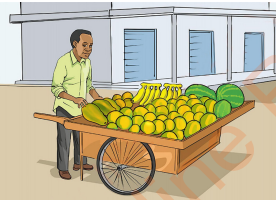Chapter 01 : Introduction to Business Studies
| Introduction When you wake up in the morning, you normally begin your day by using different products. For your personal hygiene routine, you might use a toothpaste, toothbrush, bathing soap and towel. All these products are produced by businesses. In this chapter, you will learn about the concept and scope of Business Studies, and its relationship with other disciplines. The competencies developed will enable you to appreciate the importance of business in daily life. |
| Think How the world could have been without any business. |
The concept of a business
Activities 1.1
Ask your fellow students on the following:
(a) The products they commonly consume; and
(b) Why people manufacture them?
A business is an economic activity engaged in producing or buying and selling of goods and services with the aim of earning profit through satisfying customers' needs. It offers people with a variety of things they need for survival, desire to own or use. Activity 1.1 provides some of products consumed by students. In the society, there are various businesses both large and small that take place in different places. Small businesses are such as small retail shops, selling of fresh fruits or items on street and carpentry as shown in Figure 1.1. Moreover, there are also businesses that provide services to their customers such as photography, makeup artistic, content video creation, transcribing and translating. On the other hand, large scale businesses include supermarkets, multiple shops, automotive, mobile phone companies, textile, ship building and sugar industries. In this level, concentration is on the small scale businesses.
|
(a) Small retail shop |
|
(b) A fruits vendor |
|
(c) Carpenter making furniture |
Business processes
Business activities involve the processes that an organisation engages in, to achieve its goals. These processes are production, distribution, exchange and consumption. They are explained as follows:
Production
This is a process of transforming raw materials into finished products to satisfy human needs and wants. For example, a tailor transforms a fabric into a type of a cloth such as a trouser, shirt, dress or curtains.
Distribution
This is a process of moving goods and services from where they are produced to where they are needed for consumption. For example, the transportation of manufactured sugar from Mtibwa Sugar Company in Morogoro Region to wholesalers, retailers or consumers located in various regions of Tanzania or to other countries.
Exchange
This involves buying and selling of goods and services between two or more parties. It involves the use of several means of payments, including money. Exchange enables consumers to consume items they do not produce and producers to produce what they do not consume. For example, a tailor can produce clothes for selling and not for his or her own consumption while consuming sugar produced by a sugar manufacturing company.
Consumption
This is the act of using goods and services to satisfy human needs and wants. In everyday life, individuals consume different kinds of goods and services to satisfy their needs and wants. For instance, people consume food to satisfy hunger, and buy cars for transportation. Moreover, individuals consume different services provided by doctors, teachers, the military, taxi drivers, entertainers and tourist guides.
These business processes (production, distribution, exchange and consumption) ensure that the product reaches the final consumers. However, in order to understand them better, consider an example of a school uniform that a student wears:
(a) The uniform was manufactured by a textile factory or business. This process is called the production phase.
(b) It was then transported from the factory or business to the market for consumers. This process is called the distribution phase.
(c) Then someone visited the market and bought the uniform by offering the seller some money. This process is referred to as the exchange phase.
(d) The student wears the uniform at school. This process is called the consumption phase.
Purpose of a business The main goal of any business is to generate profit. However, other purposes of businesses are to provide individuals with goods and services that satisfy their needs and wants, make goods and services that are not produced within a given area available, create employment for people to reduce unemployment, and promote innovative activities that improve delivery of goods and services. All these are done through combining the various business processes to make the items that meet peoples' demand.
Exercise 1.1
1. Kamwendo owns a small shop where he sells handmade shoes and jewellery. He advertises his products at the local market and sometimes online through social media. Does Kamwendo's small shop qualify as a business? Explain reasons for your answer.
2. Your aunt applied for a loan from a microfinance institution with the aim of opening a restaurant. However, the loan officer asked her to explain the purpose of that business. Help your aunt to explain her business purpose.
3. Mwanakombo transported woods from Njombe last month. She used them to make different furniture. Briefly, explain the business processes that Mwanakombo needs to undertake for the furniture to reach the final consumers.
Terminologies used in Business Studies
Business Studies involve understanding the main business processes, which include production, distribution, exchange and consumption. Other important terminologies for understanding Business Studies include needs and wants, services, goods, resources, scarcity, and opportunity cost. These terms are explained as follows:
Needs and wants
Create two lists of goods and services. The first list should comprise goods and services that you think are necessary for living and the second list should comprise goods and services that you desire to have.
People demand goods and services to satisfy their needs and wants. In Activity 1.2 the items listed as necessary for survival are referred to as needs, and those ones that a person desires to have are referred to as wants.
Wants on the other hand, can be goods or services an individual desires even when they are not essential. Motorcycles, televisions, and jewellery are wants because they are things that one can live without and still survive. Needs however, are goods or services an individual must have to survive. Food, shelter, water, and clothes are essential needs for a human being to be able to live.
Human needs and wants are unlimited in number. They have a tendency of multiplying in such a way that when an individual satisfies one, another one tends to arise. For example, a Form One student demands a school uniform, a school bag, and textbooks from the family budget. The same student may also need food or water to survive at school. At the same time, the student may require services of teachers, and sometimes of sports' coach in the physical education session. This means that wants increase continuously as one want is satisfied the other one arises.
Services
Services are intangible outcomes of human efforts that can satisfy human needs and wants. They command prices in exchange, and their purchase does not result in the ownership of anything physical. For example, one can only seek advice from the doctor, but cannot purchase him. Thus, a service is an act or a performance offered by one party to another. Services may be banking, online payments, education, health care, garden designing, car washing, recreation, communication, transportation, tourism and restaurants. Figure 1.2 shows health care services.
|
Figure 1.2: Health care services |
Goods Goods are valuable items that satisfies human needs or wants. The goods listed in Activity 1.2 are in the form of physical products such as sweets, cars, furniture, clothes, and houses. Goods can be categorised in different groups, for example, free and economic goods, consumer and producer goods, perishable and durable goods, and merit and demerit goods. All these categories of goods are explained as follows:
Free and economic goods: Free goods are goods which are available for consumption at no cost such as breathable air and sunlight. Economic goods on the other hand, are goods which must be bought before consumption such as a pen, a pencil, a computer, and cloth.
Consumer and producer goods: Consumer goods are goods which are produced for direct consumption such as vegetables, television sets, cars, buildings and furniture. These goods are not used for production of other goods. Producer goods on the other hand, are goods which are used for producing other goods. They include goods such as machineries, seeds, and other raw materials.
Perishable and durable goods: Perishable goods are those goods which have a short shelf life such as fruits, bread, vegetables, meat, and milk while durable goods are those goods that last for a long time such as buildings, machines, vehicles, and equipment
Merit and demerit goods: Merit goods are goods with high social benefits to consumers such as education, health services, sports facilities and fire protection while demerit goods are goods with negative impact to the society or most likely to cause health problems to the consumers such as tobacco, cigarettes and alcohol.
| Activity 1.3 In activity 1.1 goods that are commonly consumed by the students were identified, then: (a) Group them according to different categories of goods; and (b) What have you learnt from this activity. |
Resources
Resources are the inputs used to produce goods and services, also known as factors of production. These inputs include land, labour, capital and entrepreneurship. They are explained as follows:
Land is a gift of nature which includes all natural resources used in production such as minerals, forests and water.
Labour is the human efforts, skills and expertise required to produce goods and services.
Capital refers to physical or financial resources used in production. It consists of tools, machinery, equipment, finance or money and infrastructures.
Entrepreneurship involves innovation, risk taking and organisation behaviour required to bring together factors of production and create new products or business.
Scarcity
In activity 1.2 a number of things that one desires to have were listed. Probably someone wants them but does not have enough funds. Even if someone was able to buy them now, they may still want more things in the future. This is because human wants are unlimited and the resources to satisfy them are scarce.
Scarcity means shortage in supply of resources. Generally, an individual cannot have sufficient resources, income or wealth to satisfy every desire. This necessitates them to make a choice which involves fulfilling the most preferred wants to the least preferred ones.
Opportunity cost
Opportunity cost is the second best alternative foregone after making a choice. Any choice implies sacrificing something else. What is sacrificed is a loss of benefit that one would have received if they had made that choice. For example, a person who chooses to save money incurs the opportunity cost of not consuming goods and services worth the amount of money saved. Likewise, the opportunity cost of sleeping instead of working is the amount of money one could have earned if he or she had spent the time working. When making a decision, it is important to consider the opportunity cost.
Exercise 1.3
1. Baraka is a secondary school student; he needs to buy a laptop for his school activities. At the same time, he would like to buy a bicycle. However, he does not have enough money to buy both. If you were Baraka, what would you consider to make the right choice? why?
2. Your neighbour wants to open a grocery store. With reasons, advise him on the categories of goods he can sell.
3. Shukuru works in the beverage industry and earns TShs 150,000 per month. Her father retired from his work and decided to give her TShs 4,000,000 to start a business of selling school shoes and quit the beverage industry.
(a) What is the opportunity cost of Shukuru's decision to start a business?
(b) Will Shukuru's business meet consumer needs or consumer wants? Explain your answer
The concept of Business Studies
Business Studies is a multidisciplinary field that deals with the principles of business, management, and economics. It combines elements of entrepreneurship, accounting and finance, marketing, organisational studies, human resource management, and business operations.
The importance of studying Business Studies
Business Studies provide insights into the fundamental principles and dynamics that shape the world of business. Here are some reasons why studying Business Studies is important:
Entrepreneurship and innovation: Business Studies nurture an entrepreneurial mindset by teaching how to identify opportunities, create innovative solutions, and manage the risks associated with starting and growing businesses.
Understanding customer needs and Inferences: Business Studies help students to realise and appreciate the role of business in the provision of goods and services which satisfy customers' needs and wants.
Critical thinking and problem solving: Students develop critical thinking skills as they analyse business situations, make decisions, and solve complex problems related to management, marketing, finance, procurement, and operations.
Global perspective: Business Studies often explore international trade, globalisation, and cross-cultural communication, fostering an understanding of how businesses operate in a globalised world.
Financial literacy: Studying business equips individuals with financial literacy to help them manage personal finances, understand investments, and make informed decisions about saving and borrowing.
Career opportunities: Business Studies offer a wide range of career opportunities in fields such as marketing, finance, human resources, management, consulting and entrepreneurship.
Soft skills development: Students learn communication, teamwork, leadership, and negotiation skills that are applicable in both professional and personal contexts.
Ethics and corporate social responsibility: Business Studies address ethical considerations and corporate social responsibility, encouraging responsible and ethical business practices that contribute to sustainable development in the society.
Adapting to change: Business environments are constantly evolving. Studying business equips the student with skills to adapt to changes, technological advancements, and shifts in market trends.
Contribution to society: Successful businesses drive economic growth, create jobs, and contribute to the overall well-being of society. Business Studies provide insights into how businesses can positively impact communities.
Interdisciplinary learning: Business Studies often intersects with various disciplines such as economics, psychology, sociology, and technology, offering a multidimensional understanding of how these fields interact in real-world scenarios.
The scope of Business Studies
The scope of Business Studies include various components that provide comprehensive understanding of how businesses operate successfully in todays' economy. Some of the key components of Business Studies include:
Entrepreneurship: This component focuses on the process of setting up and managing a new business. It includes opportunity identification, business planning, innovation and risk taking in business operations. It entails business start-up, development and management.
Economics: This is an essential component that focuses on broader understanding of the economic environment in which the business operates. It includes concepts of wants, needs, scarcity, opportunity cost and demand and supply of goods and services in the market.
Finance and accounting. The component of finance focuses on budgeting and financial decision making while accounting focuses on recording, analysing, interpreting and reporting financial performance of an organisation.
Marketing: This component focuses on the strategies, techniques and processes that businesses use to influence and sell their products such as pricing, promoting and distributing a product.
Business management: This component encompasses the principles and practices of operating a business effectively. It includes planning, organising, directing, staffing and controlling the business resources to achieve the business goals.
Information technology and e-business: This component focuses on the role of Information and Communication Technology (ICT) in business operations. It includes e-commerce and digital marketing.
Business laws and regulations: This component focuses on understanding legal aspects for effective business operations such as compliance, employment law and contract, and intellectual property.
Risk management: This component focuses on identifying potential risks that a business may encounter and developing effective ways to overcome the risks, including insurance.
Exercise 1.3
1. Makame is a new Form One student who is ambitious to become a business person. Explain to Makame how Business Studies will help him achieve that goal.
2. Business Studies is a combination of various fields of study. Justify the statement.
Relationship between Business Studies and other subjects
Business Studies relate with all subjects as it prepares and allows students to transfer knowledge, skills and attitudes acquired from various subjects into business opportunities. The subject develops the capacity of students to identify opportunities and transfer them into businesses. The relationship between Business Studies with a few selected subjects namely Agriculture, Music, Theatre arts, English language, Kiswahili, Arabic, Chinese language, French, and Mathematics is described as follows:
Business Studies with Agriculture Students studying Agriculture may learn how to cultivate vegetables but may lack skills of making it a business that earns money. Thus, Business Studies will equip the students with business skills which will enable them to turn vegetable cultivation into a profit-making business.
Business Studies with Theatre arts and Music subjects Students who are taking Theatre arts and music subjects may decide to start their own acting schools and production companies. Business Studies will equip them with necessary skills to create a business plan, manage the business finances and marketing their services.
Business Studies with Language subjects Students who are taking language subjects such as English, Kiswahili, Arabic, Chinese and French acquire translation, interpreting and editing skills. Business Studies will enable them to promote their skills to become translators, interpreters, editors and content creators for websites and social media.
Business Studies with Mathematics Mathematics is like a toolkit for entrepreneurship and Business Studies. Mathematics helps entrepreneurs create successful businesses. It helps them with aspects like budgeting, measuring how well ideas are working, and making smart decisions about money. Mathematics provides the power to turn creative ideas into real-world successes by focusing on details, patterns, and innovative solutions.
| Activity 1.4 Review various sources including Internet and explain the relationship between Business Studies and other subjects that you are pursuing in your current academic stream. |
| Out of class activity Pay a visit to the local community, speak to different people and observe the surroundings. (a) What are some common needs and wants in the community? (b) Reflect on the needs and wants in the community that can become businesses. |
Skills lab activity
Based on the knowledge acquired on business, choose any business which you may wish to establish with consideration of the needs of your community.
Project activity
In your business club, prepare a short report on the type of a business you would like to establish and state its purpose
Chapter summary
1. A business is an organisation that deals with producing or buying and selling of goods and services with the aim of earning profit and satisfying customers' needs.
2. Most businesses are established with the main purpose of generating profit. However, other purposes include job creation, satisfying human needs, ensuring availability of goods and services, and innovation to improve goods and services delivery.
3. Business Studies is a broad field that deals with the principles of business, management, and economics. Its scope includes various components which are entrepreneurship, economics, finance and accounting, marketing, business management, Information and Communication Technology (ICT) and e-business, and business laws and regulations.
4. Business Studies is an important field as learners acquire basic knowledge, skills and attitude towards setting up and running an enterprise.
5. The main significance of Business Studies in relation to other disciplines is the transfer of students' knowledge, skills, values and attributes into the formation of businesses that solve community needs.
6. Business Studies allows the students to develop capacity to identify opportunities in different subjects and transform them into business.
www.learninghubtz.co.tz
Revision Exercise
In each of the questions 1 to 5, choose the correct answer among the given alternatives and write its letter in your exercise book.
1. Who is the final user of goods and services?
- Distributor
- Retailer
- Manufacturer
- Consumer
2. Which one of the following IS NOT considered as a business?
- An organisation which engages in buying and selling of goods
- An enterprise owned by a single person
- The process of recording business transactions
- Any activity aiming at generating profit
3. One of the following IS NOT regarded as a consumer need
- Clothing
- Housing
- Holiday
- Water
4. Which one among the following IS NOT an input for production?
- Land
- Capital
- Consumer
- Labour
5. Which one among these is a component of Business Studies?
- Entrepreneurship
- Accounting
- Business Management
- All of the above
6. Match the items from Group A with those in Group B by writing the letter of a correct option in Group B that corresponds to an item in Group A
| Group A | Group B |
|
|
7. Briefly explain the following terms:
(a) Goods
(b) Exchange
(c) Wants
(d) Resources
8. With examples, explain different business activities carried out in your community.
9. Briefly explain the concepts of scarcity and opportunity cost.
10. Briefly explain the importance of studying Business Studies in peoples' daily life.
Hub App
 For Call,Sms&WhatsApp: 255769929722 / 255754805256
For Call,Sms&WhatsApp: 255769929722 / 255754805256
 For Call,Sms&WhatsApp: 255769929722 / 255754805256
For Call,Sms&WhatsApp: 255769929722 / 255754805256
WHATSAPP US NOW FOR ANY QUERY
App Ya Learning Hub Tanzania










